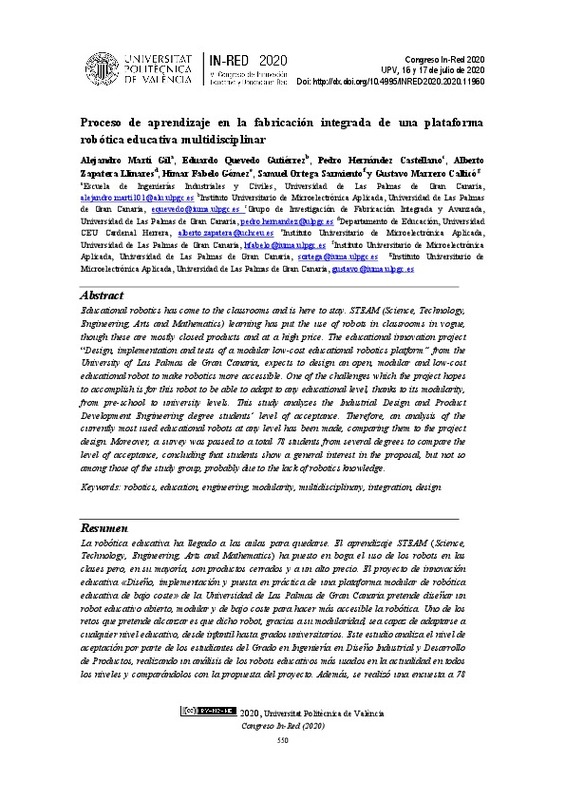JavaScript is disabled for your browser. Some features of this site may not work without it.
Buscar en RiuNet
Listar
Mi cuenta
Estadísticas
Ayuda RiuNet
Admin. UPV
Proceso de aprendizaje en la fabricación integrada de una plataforma robótica educativa multidisciplinar
Mostrar el registro sencillo del ítem
Ficheros en el ítem
| dc.contributor.author | Martí Gil, Alejandro
|
es_ES |
| dc.contributor.author | Quevedo Gutiérrez, Eduardo
|
es_ES |
| dc.contributor.author | Hernández Castellano, Pedro
|
es_ES |
| dc.contributor.author | Zapatera Llinares, Alberto
|
es_ES |
| dc.contributor.author | Fabelo Gómez, Himar
|
es_ES |
| dc.contributor.author | Ortega Sarmiento, Samuel
|
es_ES |
| dc.contributor.author | Marrero Callicó, Gustavo
|
es_ES |
| dc.date.accessioned | 2021-02-16T08:41:15Z | |
| dc.date.available | 2021-02-16T08:41:15Z | |
| dc.date.issued | 2021-02-16T08:41:15Z | |
| dc.identifier.isbn | 978-84-9048-833-1 | |
| dc.identifier.issn | 2603-5863 | |
| dc.identifier.uri | http://hdl.handle.net/10251/161409 | |
| dc.description.abstract | [ES] La robótica educativa ha llegado a las aulas para quedarse. El aprendizaje STEAM (Science, Technology, Engineering, Arts and Mathematics) ha puesto en boga el uso de los robots en las clases pero, en su mayoría, son productos cerrados y a un alto precio. El proyecto de innovación educativa «Diseño, implementación y puesta en práctica de una plataforma modular de robótica educativa de bajo coste» de la Universidad de Las Palmas de Gran Canaria pretende diseñar un robot educativo abierto, modular y de bajo coste para hacer más accesible la robótica. Uno de los retos que pretende alcanzar es que dicho robot, gracias a su modularidad, sea capaz de adaptarse a cualquier nivel educativo, desde infantil hasta grados universitarios. Este estudio analiza el nivel de aceptación por parte de los estudiantes del Grado en Ingeniería en Diseño Industrial y Desarrollo de Productos, realizando un análisis de los robots educativos más usados en la actualidad en todos los niveles y comparándolos con la propuesta del proyecto. Además, se realizó una encuesta a 78 alumnos de ingeniería, concluyendo que muestran un interés general por la propuesta, pero no tanto entre los del grupo de estudio, probablemente debido a la falta de conocimientos de robótica. | es_ES |
| dc.description.abstract | [EN] Educational robotics has come to the classrooms and is here to stay. STEAM (Science, Technology, Engineering, Arts and Mathematics) learning has put the use of robots in classrooms in vogue, though these are mostly closed products and at a high price. The educational innovation project “Design, implementation and tests of a modular low-cost educational robotics platform” from the University of Las Palmas de Gran Canaria, expects to design an open, modular and low-cost educational robot to make robotics more accessible. One of the challenges which the project hopes to accomplish is for this robot to be able to adapt to any educational level, thanks to its modularity, from pre-school to university levels. This study analyzes the Industrial Design and Product Development Engineering degree students’ level of acceptance. Therefore, an analysis of the currently most used educational robots at any level has been made, comparing them to the project design. Moreover, a survey was passed to a total 78 students from several degrees to compare the level of acceptance, concluding that students show a general interest in the proposal, but not so among those of the study group, probably due to the lack of robotics knowledge. | es_ES |
| dc.format.extent | 15 | es_ES |
| dc.language | Español | es_ES |
| dc.publisher | Editorial Universitat Politècnica de València | es_ES |
| dc.relation.ispartof | IN-RED 2020: VI Congreso de Innovación Educativa y Docencia en Red | |
| dc.rights | Reconocimiento - No comercial - Sin obra derivada (by-nc-nd) | es_ES |
| dc.subject | Modular design | es_ES |
| dc.subject | Modularity | es_ES |
| dc.subject | Industrial design | es_ES |
| dc.subject | Robotics | es_ES |
| dc.subject | Robótica educativa | es_ES |
| dc.subject | Diseño industrial | es_ES |
| dc.subject | Diseño modular | es_ES |
| dc.subject | Robótica | es_ES |
| dc.subject | Educación superior | es_ES |
| dc.subject | Enseñanza superior | es_ES |
| dc.subject | Tecnologías y educación | es_ES |
| dc.subject | Innovación educativa | es_ES |
| dc.title | Proceso de aprendizaje en la fabricación integrada de una plataforma robótica educativa multidisciplinar | es_ES |
| dc.type | Capítulo de libro | es_ES |
| dc.type | Comunicación en congreso | es_ES |
| dc.identifier.doi | 10.4995/INRED2020.2020.11960 | |
| dc.rights.accessRights | Abierto | es_ES |
| dc.description.bibliographicCitation | Martí Gil, A.; Quevedo Gutiérrez, E.; Hernández Castellano, P.; Zapatera Llinares, A.; Fabelo Gómez, H.; Ortega Sarmiento, S.; Marrero Callicó, G. (2021). Proceso de aprendizaje en la fabricación integrada de una plataforma robótica educativa multidisciplinar. En IN-RED 2020: VI Congreso de Innovación Educativa y Docencia en Red. Editorial Universitat Politècnica de València. 550-564. https://doi.org/10.4995/INRED2020.2020.11960 | es_ES |
| dc.description.accrualMethod | OCS | es_ES |
| dc.relation.conferencename | IN-RED 2020: VI Congreso de Innovación Educativa y Docencia en Red | es_ES |
| dc.relation.conferencedate | Julio 16-17, 2020 | es_ES |
| dc.relation.conferenceplace | Valencia, España | es_ES |
| dc.relation.publisherversion | http://ocs.editorial.upv.es/index.php/INRED/INRED2020/paper/view/11960 | es_ES |
| dc.description.upvformatpinicio | 550 | es_ES |
| dc.description.upvformatpfin | 564 | es_ES |
| dc.type.version | info:eu-repo/semantics/publishedVersion | es_ES |
| dc.relation.pasarela | OCS\11960 | es_ES |








